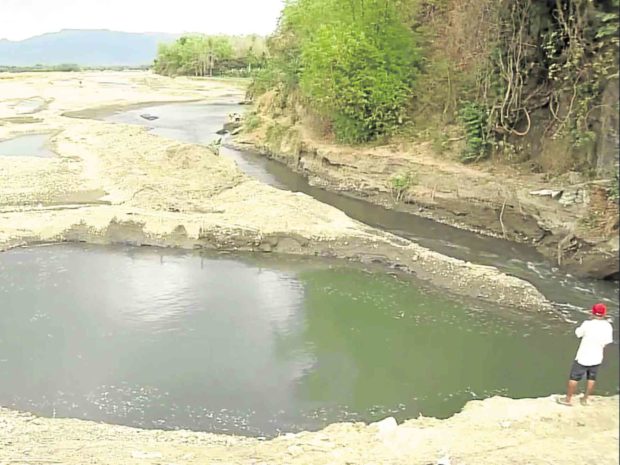39°C heat in Occidental Mindoro takes deadly toll on farms

ALL THAT’S LEFT A drone shot of Busuanga River in Occidental Mindoro shows water receding since the start of drought in February. —PHOTO FROM SAN JOSE MUNICIPAL GOVERNMENT
Household taps in Occidental Mindoro have run dry as intense heat continued to ravage farms and water sources in the province prompting an agriculture official to raise fear that the worst was yet to come, and a mayor to liken the heat to standing on top of hell.
“We don’t have a water source, like dams, so the only source, even of potable water, is the river,” said Romel Calingasan, agriculture officer of San Jose town.
“But even the river has already dried up, as in nothing flows anymore,” he said.
Residents of San Jose have formed groups, or “clusters” to install manual water pumps and share their yield.
Others collect drinking water from towns which continued to have water.
Article continues after this advertisementIrony
Article continues after this advertisementCalingasan said all that’s left of Busuanga River, which used to supply water to households and farms, was its rocky bed.
It was ironically the same river, which lies between San Jose and the town of Rizal, that had swelled in 2018 during a storm and flooded many communities.
Farmer Amalia Manahan, 37, said crops on 1 hectare of her 3-ha farm had dried up “beyond recovery.”
“I’m just hoping we could still harvest at least some of the remaining vegetables,” she said.
State of calamity has been declared in San Jose and Rizal as the dry spell was projected to linger for at least two months.
Next to hell
The Disaster Risk Reduction and Management Council (DRRMC) of Mimaropa (Mindoro, Marinduque, Romblon and Palawan) region said more than 6,000 farmers lost income and 9,000 ha of farms were drying up.
“It’s really hot now,” said San Jose Mayor Romulo Festin. “It’s like we’re standing right above hell,” he added.
Festin said municipal government officials had started distributing fuel for pumps to be used to extract water from deep wells.
Long wait
Some farmers, he said, had started looking for jobs in construction sites to earn a living after losing their crops to the heat.
Tony Gerundio, regional director of the Department of Agriculture, said 3,000 farmers had been recommended for a cash-for-work program of the Department of Social Welfare and Development.
“Even spring wells are dry,” San Jose agriculturist Calingasan said. “If there’s water, it lasts for up to only two weeks,” he added.
Residents, he said, dug wells as deep as 10 meters but nothing much came out of these.
To conserve whatever water was left, Calingasan said farmers’ groups implement “flashing,” or rationing.
“It takes about five to seven days before your farm gets your turn again for water,” he said.
The problem, Calingasan said, was that crops at this time were at their reproductive stage, which required a huge amount of water to survive.
“So assuming they survive this season, the yield will still not be that much,” he said.
The Philippine Atmospheric, Geophysical and Astronomical Services Administration, in recent meetings with the local government of San Jose, said the average heat index in the town alone had reached 39°C, or at least 7 degrees more than the town’s normal average heat index of 32°C during summer months. In comparison, a person with high fever normally clocks a body temperature of 38°C.
Record heat
Calingasan said this surpassed the highest recorded heat index of 36.2°C in San Jose in 2016, also an El Niño year.
He said there was no longer enough pressure to pump water through shallow tube wells to household taps.
“There are just a few of drops of water coming out of our faucets,” Calingasan said.
“When you open two faucets at the same time, nothing comes out anymore,” he added.
In Occidental Mindoro, the cost of damaged crops has so far reached P36.8 million.
The regional DRRMC estimated P59.8 million worth of agricultural losses in Mimaropa.